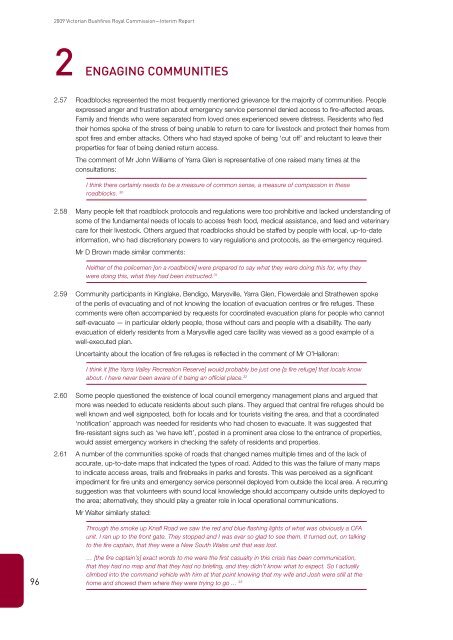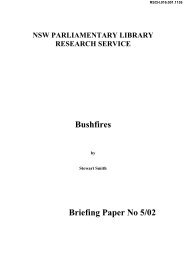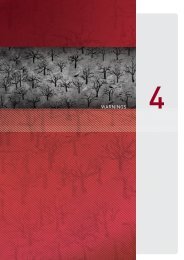engaging communities - 2009 Victorian Bushfires Royal Commission
engaging communities - 2009 Victorian Bushfires Royal Commission
engaging communities - 2009 Victorian Bushfires Royal Commission
Create successful ePaper yourself
Turn your PDF publications into a flip-book with our unique Google optimized e-Paper software.
<strong>2009</strong> <strong>Victorian</strong> <strong>Bushfires</strong> <strong>Royal</strong> <strong>Commission</strong>—Interim Report<br />
2 ENGAGING COMMUNITIES<br />
2.57<br />
Roadblocks represented the most frequently mentioned grievance for the majority of <strong>communities</strong>. People<br />
expressed anger and frustration about emergency service personnel denied access to fire-affected areas.<br />
Family and friends who were separated from loved ones experienced severe distress. Residents who fled<br />
their homes spoke of the stress of being unable to return to care for livestock and protect their homes from<br />
spot fires and ember attacks. Others who had stayed spoke of being ‘cut off’ and reluctant to leave their<br />
properties for fear of being denied return access.<br />
The comment of Mr John Williams of Yarra Glen is representative of one raised many times at the<br />
consultations:<br />
I think there certainly needs to be a measure of common sense, a measure of compassion in these<br />
roadblocks. 30<br />
2.58<br />
Many people felt that roadblock protocols and regulations were too prohibitive and lacked understanding of<br />
some of the fundamental needs of locals to access fresh food, medical assistance, and feed and veterinary<br />
care for their livestock. Others argued that roadblocks should be staffed by people with local, up-to-date<br />
information, who had discretionary powers to vary regulations and protocols, as the emergency required.<br />
Mr D Brown made similar comments:<br />
Neither of the policemen [on a roadblock] were prepared to say what they were doing this for, why they<br />
were doing this, what they had been instructed. 31<br />
2.59<br />
Community participants in Kinglake, Bendigo, Marysville, Yarra Glen, Flowerdale and Strathewen spoke<br />
of the perils of evacuating and of not knowing the location of evacuation centres or fire refuges. These<br />
comments were often accompanied by requests for coordinated evacuation plans for people who cannot<br />
self-evacuate — in particular elderly people, those without cars and people with a disability. The early<br />
evacuation of elderly residents from a Marysville aged care facility was viewed as a good example of a<br />
well-executed plan.<br />
Uncertainty about the location of fire refuges is reflected in the comment of Mr O’Halloran:<br />
I think it [the Yarra Valley Recreation Reserve] would probably be just one [a fire refuge] that locals know<br />
about. I have never been aware of it being an official place. 32<br />
2.60<br />
2.61<br />
Some people questioned the existence of local council emergency management plans and argued that<br />
more was needed to educate residents about such plans. They argued that central fire refuges should be<br />
well known and well signposted, both for locals and for tourists visiting the area, and that a coordinated<br />
‘notification’ approach was needed for residents who had chosen to evacuate. It was suggested that<br />
fire-resistant signs such as ‘we have left’, posted in a prominent area close to the entrance of properties,<br />
would assist emergency workers in checking the safety of residents and properties.<br />
A number of the <strong>communities</strong> spoke of roads that changed names multiple times and of the lack of<br />
accurate, up-to-date maps that indicated the types of road. Added to this was the failure of many maps<br />
to indicate access areas, trails and firebreaks in parks and forests. This was perceived as a significant<br />
impediment for fire units and emergency service personnel deployed from outside the local area. A recurring<br />
suggestion was that volunteers with sound local knowledge should accompany outside units deployed to<br />
the area; alternatively, they should play a greater role in local operational communications.<br />
Mr Walter similarly stated:<br />
Through the smoke up Knafl Road we saw the red and blue flashing lights of what was obviously a CFA<br />
unit. I ran up to the front gate. They stopped and I was ever so glad to see them. It turned out, on talking<br />
to the fire captain, that they were a New South Wales unit that was lost.<br />
96<br />
… [the fire captain’s] exact words to me were the first casualty in this crisis has been communication,<br />
that they had no map and that they had no briefing, and they didn’t know what to expect. So I actually<br />
climbed into the command vehicle with him at that point knowing that my wife and Josh were still at the<br />
home and showed them where they were trying to go ... 33
















